For a few words about my
reviewing process and preferences, please see the introduction to
Classical Reviews # 36.

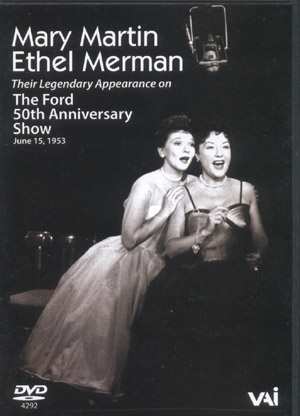 |
MARY MARTIN AND ETHEL MERMAN: VAI
DVD 4292
|
|
0 |
5 |
|
Performance |
 |
|
Sonics |
 |
|
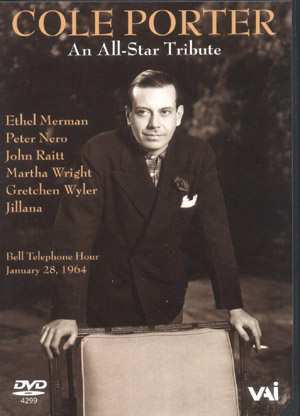 |
COLE PORTER: AN ALL-STAR TRIBUTE •
VAI DVD 4299
|
|
0 |
5 |
|
Performance |
 |
|
Sonics |
 |
|
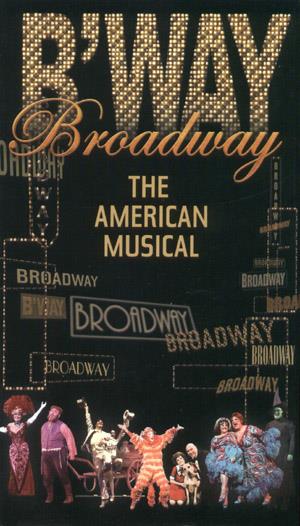 |
BROADWAY: THE AMERICAN MUSICAL •
COLUMBIA MASTERWORKS 92899
|
|
0 |
5 |
|
Performance |
 |
|
Sonics |
 |
|
BROADWAY GREATS
Every list of the greatest singing actresses of the last 75 years puts Ethel
Merman and Mary Martin at or near the top. Born five years apart, their
premieres of music by George & Ira Gershwin, Cole Porter, Richard Rodgers &
Oscar Hammerstein II, and Irving Berlin grants them virtual immortality in
the lexicon of American popular song.
Released in time for holiday giving, Merman and Martin's ratings-setting
joint TV appearance on The Ford 50th Anniversary Show of June 15, 1953,
staged and conceived by Jerome Robbins, is finally available on DVD from VAI.
The entire segment may run only 27-minutes, but it reveals what made these
women so in demand by composers and audiences.
Ethel Merman (Ethel Agnes Zimmerman) from Astoria, Queens was all of 22 when
she left a back-up career in stenography to star in the Gershwin's 1930 Girl
Crazy. Her clarion C in “I Got Rhythm,” held for 16 measures of
encore-demanding ecstasy, became one hallmark of her brash, riveting style.
Another was her “No Business Like Show Business” persona, whose combination
of voice and drive mostly triumphed over a noticeable lack of glamour and an
accent decidedly more fish market than Saks Fifth.
Starting with 1934's Anything Goes (which contained the Porter classics
"Blow Gabriel Blow,” "I Get a Kick Out of You,” and "You're the Top"),
Merman's trumpet voice projected her into leads in four Cole Porter
musicals. “I'd rather write for Ethel than for anyone else in the world,”
wrote Porter. “Every composer has his favorite, and she is mine. She has the
finest enthusiasm of any American singer I know.”
Later came such gems as Berlin's Annie Get Your Gun and the 1959 Laurents/Styne/Sondheim
Gypsy. All together, Merman starred in 13 Broadway shows in a period of 29
years. Most of her signature numbers can be heard complete or in snippets on
either her joint appearance with Martin or The Bell Telephone Hour January
28, 1964 Cole Porter: An All-Star Tribute (also on VAI).
Mary Virginia Martin hailed from Weatherford, Texas. She was nearing 25 when
she achieved Broadway fame in 1938 with her naïve rendition of Cole Porter's
“My Heart Belongs to Daddy.” Further Broadway appearances in musicals by
Noel Coward, Rodgers & Hammerstein (South Pacific and The Sound of Music),
Styne/Comden & Green (Peter Pan), plus touring in roles originally created
by Merman and Carol Channing, made her an equally indispensable theatrical
presence.
It was impossible to watch and listen to Martin without feeling the warmth
of her incomparable charm and genuine love for the music she sang. Her joint
TV appearance with the irrepressibly witty Noel Coward, which includes a
comic rendition of Madame Butterfly's tragic “Un bel di” should be required
viewing for anyone considering coming out.
The Merman/Martin joint TV appearance begins with Merman's vocal trumpet
blaring Berlin's “Alexander's Ragtime Band” like no one else could or can.
She first sang the tune in the 1938 movie of the same name, broadcasting the
signature brass timbre that remained even through her later years of
widening vibrato and forgivable campy excursion into disco.
After clowning it up on “Mademoiselle from Armentières,” Merman cedes to
Martin's eye-opening 7-minute silent stint in The Fashion Show (“The
Shape”). Using only pantomime and a few props, Martin's physical freedom and
infectious wit convert a floor-length tube stocking into a hilarious tour
through the devolution of women's fashion. Those expecting a rather square,
sanitizedskit will be amazed by how funny Martin could be.
The DVD ends with a 30-song medley that mixes tunes that the women
introduced with others from an earlier era. “Wait ‘Till the Sun Shines
Nellie” may grab your grandmother more than you, but “I Got Rhythm” and
“There's No Business Like Show Business” (which both women sang onstage)
sound as alive today as in 1953.
Perhaps it's just the sound on this particular color special, but Merman's
singing and movement on the 1964 Cole Porter Tribute suggest that the
56-year old wonder had by then passed her peak. The narration is stilted,
the movement limited, and the very notion of joining Peter Nero, John Raitt,
Martha Wright, Gretchen Wyler, and Jillana to squeeze 52 Porter songs into
an hour perhaps motivated more by the wish to get it all in before Porter
died (late that year) than concern for musical values. Merman seems to throw
in one too many of her trademark grace notes in an attempt to light a fire
under vocal chords that no longer spark as they used to.
Merman on a bad night was still inimitable, but handsome John Raitt's once
stirring voice had turned prosaically gruff. Peter Nero and Martha Wright's
contributions are best left unspoken, and ballerina Jillana's pointe seems
pointless in Porter. Thankfully, Gretchen Wyler's singing and dancing are a
joyful revelation. And some of the boys in the dancing numbers are so, so…
Besides Wyler, the raison d'etre for owning The Porter Tribute is the bonus
footage of Merman on the Bell Telephone Hour of January 29, 1960. Beginning
with the familiar “Alexander's” and ending with “I Got Rhythm,” Merman's
ragtime medley finds her totally in her element. Most valuable are the nine
alternate takes that show her winding up and deflating in consummate
professional fashion as the Director shouts “Cut!” Mama Rose could teach us
all a thing or too.
Seeing Merman and Martin honor Porter becomes even more vital as the Special
Edition DVD of Irwin Winkler's Porter story De-Lovely hits the shelves.
Enough has already been written about the movie's focus on Porter's
homosexuality. Suffice it to say that what suffers most is the music. With
some of America's most witty and sophisticated popular melodies and lyrics
used for biographical ends, the joy of Porter becomes buried alive as
background music for morbidity. What in the world are Natalie Cole, Diana
Krall, and a host of other contemporaries singing like their 21st century
selves in a film that pretends to historical accuracy?
Best instead to end our Broadway tour with the 5-CD Broadway: The American
Musical set from Columbia Broadway Masterworks/Legacy. Virtually all music
from the recent three-part PBS special narrated by Julie Andrews is heard
here save for a few tracks preserved only on rare screen and TV footage.
Compare Martin's 1938 “My Heart Belongs to Daddy” with her 1953 rendition to
discover how her singing style evolved over the years.
While I wouldn't argue with anyone who prefers to buy the DVD of this PBS
series, CD offers better sound and uninterrupted listening without having to
suffer through dialogue and musical excerpts. The 55-page oversize booklet
is filled with essential information (available in different form on the PBS
website) and graphics. What you'll miss are the moving footage and
commentary that drive home racism's impact on Broadway -- a heart-rending
Ethel Waters TV appearance must be seen -- and the steps taken by brave
composers, lyricists, producers and artists to bring blacks and other
minorities to the front of the stage.

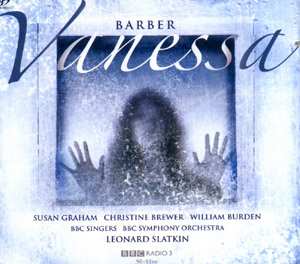 |
BARBER: VANESSA • CHANDOS SACD CHSA
5032(2)
|
|
0 |
5 |
|
Performance |
 |
|
Sonics |
 |
|
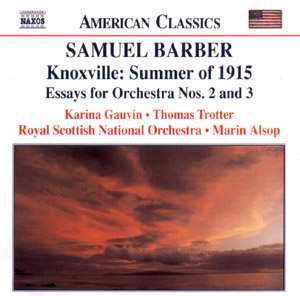 |
BARBER: KNOXVILLE, SUMMER OF 1915,
SECOND AND THIRD ESSAYS FOR ORCHESTRA, TOCCATA FESTIVA • NAXOS
8.559134
|
|
0 |
5 |
|
Performance |
 |
|
Sonics |
 |
|
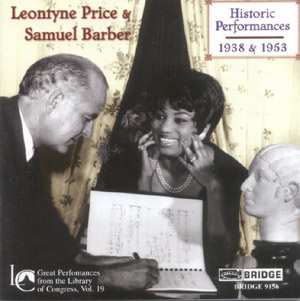 |
LEONTYNE PRICE AND SAMUEL BARBER •
BRIDGE 9156
|
|
0 |
5 |
|
Performance |
 |
|
Sonics |
 |
|
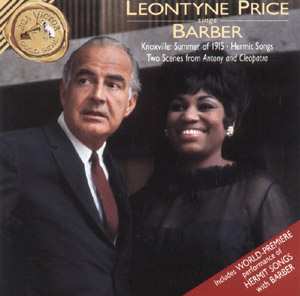 |
LEONTYNE PRICE SINGS BARBER •
RCA/BMG 09026-61983-2
|
|
0 |
5 |
|
Performance |
 |
|
Sonics |
 |
|
THE MUSIC OF SAMUEL BARBER
One of our most noteworthy 20th century composers, Samuel Barber (1910-1981)
is esteemed primarily for his beloved if overplayed Adagio for Strings and a
handful of works for voice. While the gorgeous, oft-performed 16-minute
Knoxville, Summer of 1915 is represented by no less than 12 recordings in
print, Barber's opera Vanessa has received short shrift until now.
Chandos' new recording of Barber's revised version of Vanessa features a
star-studded line-up of soloists -- Susan Graham (Erika), Christine Brewer
(Vanessa), and William Burden (Anatol) -- that rivals the original-cast
recording featuring Rosalind Elias, Eleanor Steber, and Nicolai Gedda
conducted by the Dmitri Mitropoulos. Not only do the BBC Symphony Orchestra
and BBC Singers under Leonard Slatkin do a bang-up job, but Chandos has also
gone full out, producing a vivid, state-of-the-art multi-channel SACD that
sounds great in two-channel stereo.
Though some politely term Vanessa “American verismo,” mid-century melodrama
is far more like it. The opera's potboiler of a libretto, fashioned by
Barber's longtime companion Gian Carlo Menotti, may occasionally cause eyes
to roll, but Barber's keen dramatic sense and unabashed lyricism do much to
save the day.
The story centers around the wealthy Vanessa, who has spent 20 years walled
up in her country estate lamenting the end of her affair with a married man
named Anatol. Surrounded by her young niece Erika and her elderly mother the
Baroness, Vanessa awaits Anatol's supposed return. In his place arrives his
young son, also named Anatol, who within a scene or two impregnates Erika
while wooing Vanessa.
The opera opens with two character-defining arias, Erika's gorgeous “Must
the winter come so soon” followed by Vanessa's urgent “He has come!” If the
former presents Erika as a virgin of touching vulnerability, the latter
introduces an imperious soprano of an ice princess who in short order melts
à la Turandot.
Erika is not an ideal vehicle for the sensuous Susan Graham, but the mezzo's
beauty of voice creates much sympathy for a pathetic character who by the
opera's end walls herself off like her aunt. Soprano Christine Brewer excels
as Vanessa; her combination of vocal force and beauty rivals Barber favorite
Leontyne Price in “He shall come,” everywhere making the character as
credible as possible. Brewer's ability to flawlessly transition from
orchestra-dominating utterance to impeccably floated highs makes her a vocal
if not visual natural for the part.
Tenor William Burden's Anatol invokes mixed reactions. With a voice as sweet
as his handsome visage, Burden sounds several degrees too nice for a stinker
whose cynicism and duplicity deserve contempt. While his “Love has a bitter
core, Vanessa” communicates a modicum of irony, his energy seems far more
suited for the innocent Peleas he's singing at the Met than the cunning cad
who indelibly wounds Erika while exploiting her aunt. At his best in the
tender air “On the path to the lake,” where his gorgeous falsetto speaks
volumes, Burden inspires listeners to overlook Vanessa and Erika pain and
instead throw themselves at Anatol's feet. Not what Barber and Menotti
intended.
Regardless, there's too much wonderful music in this opera to miss. Beyond a
host of memorable solo vehicles for all five major characters – Neal Davies
does a superb job with the Old Doctor's aria -- and an Act II Tosca-like
duet for Vanessa and Anatol, Barber penned a final act quintet (“To leave,
to break, to find, to keep”) that for beauty and poignancy alone rivals the
quartet from Rigoletto and sextet from Lucia.
Eleven years before Vanessa's Salzburg premiere, Barber found an ideal
vehicle for his lyricism in James Agee's Knoxville Summer of 1915. The
singsong simplicity of his music's opening phrases, redolent of a lazy
summer evening in Tennessee, draws us into a state of child mind from which
the narration flows. Commissioned and premiered by Eleanor Steber, whose
1950 recording reveals a less than ideal vocal maturity and formality of
pronunciation, the work demands a soprano with voice and imagination
sufficient to segue between the child's simplicity of utterance and
unexpectedly dramatic, precocious questioning.
Of the three versions issued in the last six months, that from the gifted
Karina Gauvin and the Royal Scottish National Orchestra (Naxos) deserves
must-hear status thanks in large part to Marin Alsop's sympathetic
conducting. Alsop savors every aspect of the colorful score, paying equal
attention to the loud auto, the blue dew on the rough wet grass, and the
child's questioning of ultimate identity. Her conducting perfectly
complements Gauvin's lovely, lyrical (albeit womanly and anything but
southern), low-key reading.
To these ears, the Gauvin/Alsop collaboration joins two others of major
stature. One is Dawn Upshaw's partnership with David Zinman, where her
girl-like timbre and shimmering vibrato on high prove irresistible.
The other is Leontyne Price's tour de force with the Thomas Schippers. Price
begins with childlike voice and minimal vibrato, only to transition into
such an unrivalled combination of vocal and orchestral splendor as to make
us care less that the child has inexplicably vanished. (It reminds me a bit
of Callas' Butterfly, where the Diva holds back and sings in little girl
voice until tragedy takes over and the voice suddenly takes on the weight of
maturity).
Price inspired for four Barber premieres, the third being his opera Antony
and Cleopatra. The opera's failed 1966 Met opening was due in part to a
malfunctioning, life imitates art stage set that left Ms. Price trapped in a
pyramid à la Aida. (To quote critic Peter G. Davis: “…it was definitely a
rocky occasion: for Met general manager Rudolf Bing, who had watched the
company's expensive new stage machinery break down before his eyes during
rehearsals; for Leontyne Price as Cleopatra, who got trapped inside a huge
pyramid; for director Franco Zeffirelli, whose outrageously glitzy
production virtually obliterated the opera (‘Oh, my God, a gay asp!'
exclaimed one fed-up spectator behind me at the dress rehearsal as Cleopatra
applied a garish spangled snake to her breast); and especially for Barber,
who was so crushed by the whole experience that he left the country and
composed scarcely anything of consequence for the rest of his life.” Two
arias from the opera, recorded two years after the failed premiere, are
included on the same RCA Victor recording that also features Price's
Knoxville tour de force and a sonically enhanced version of her 1953 Hermit
Songs Library of Congress world premiere with Barber at the piano.
Bridge has recently released the same Hermit Songs world premiere. This is
the first time that the entire recital (including songs by Barber, Sauguet,
Poulenc and Fauré) has been issued intact. Bridge may not have cleaned up
the sound of the original tape as did RCA, but the resultant rawness adds to
the sense of occasion.
Price was all of 26 and fresh from touring in Porgy and Bess when she came
to D.C. The audience discovered a remarkable voice well on its way to the
glorious bloom of womanhood. By the time Price and Barber made their New
York recital début the following year, the title “goddess” had already been
bestowed upon the diva.
The Bridge disc also includes baritone Samuel Barber's self-accompanied 1938
recital at the Curtis School of Music. Barber's remarkably even vocal
production and gift for lyrical if at times over-romanticized utterance
speak volumes about his future compositions. Don't miss this disc.
Awaiting US release is Alsop's final installment in her Naxos Barber series.
Headlined by the Capricorn Concerto, named for a house Barber shared with
Menotti, the CD also includes the Intermezzo from Vanessa and a late
Canzonetta posthumously scored by Barber's friend Charles Turner. Given
Gramophone critic Peter Dickinson's prediction that the elegiac Canzonetta
“could become as popular as the famous Adagio,” anticipation of a sort far
more positive than Vanessa's is the order of the day.

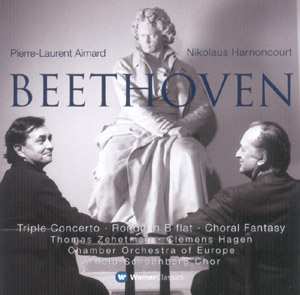 |
BEETHOVEN:TRIPLE CONCERTO • RONDO IN
B FLAT • CHORAL FANTASY • WARNER CLASSICS
|
|
0 |
5 |
|
Performance |
 |
|
Sonics |
 |
|
It boggles the mind that Ludwig van Beethoven's glorious Triple Concerto
for violin, piano, cello, and orchestra received only one performance in his
lifetime. A sinfonia concertante written for Beethoven's young piano pupil
Archduke Rudolph and two string players in his entourage, it called for a
novel combination of piano trio and orchestra that audiences were not yet
accustomed to. The work's failure to engage the Viennese public of 1808,
blamed on indifferent soloists, might never have occurred had Beethoven been
honored by musicians of the level heard on this marvelous recording.
This performance, featuring violinist Thomas Zehetmair, cellist Clemens
Hagen of the Hagen Trio, and pianist Pierre-Laurent Aimard with the Chamber
Orchestra of Europe conducted by the great authentic instrument pioneer
Nikolaus Harnoncourt, stands alongside the classic reading by Oistrakh,
Rostropovich, and Richter with the Berlin Philharmonic conducted by Karajan
as among the best ever committed to disc. This new team of soloists and
conductor clearly love Beethoven's tuneful treat with its countless engaging
variations. Phrases are voiced with increasingly subtlety as gentle shadings
and tender caresses nimbly pass from one instrument to the other. Playing a
modern instrument considerably heavier than the pianos of Beethoven's time,
Aimard adopts a gentle touch that supports rather than overwhelms the string
players. The meditative middle movement, whose rapt spirituality is
reminiscent of a similar movement in Beethoven's Archduke Trio, leads
immediately into an energetic, joyful finale that makes one want to hit
repeat.
Beethoven's early Rondo in B flat for piano paves the way for his Choral
Fantasia in C minor, a work that sometimes sounds like a warm-up for the
glorious “Ode to Joy” of his final Ninth Symphony. The work was composed as
a last-minute addition to Beethoven's marathon benefit concert in the
Viennese Theater an der Wien on December 22, 1808, a concert that included
the fist public performances of the Fifth and Sixth Symphonies, three
movements from the C major Mass, the concert aria “Ah, perfido!” and the
premiere of the Fourth Piano Concerto,with Beethoven himself playing the
solo part. (So much for modern audience members who can't stand to sit for
more than two hours).
The rousing finale of the Chorale Fantasia in C minor, which brings into
play soloists, chorus and orchestra, is a setting of a poem in praise of
universal harmony and the triumph of light over darkness. The movement's
familiar theme offers a naive foretaste of the yet-to-be-composed, far more
refined final symphonic chorale of Beethoven's Ninth Symphony. It's not
Beethoven at his best, but it's the Triple Concerto that deserves your
attention.

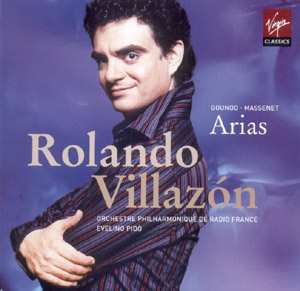 |
ROLANDO VILLAZÓN: MASSENET/GOUNOD
ARIAS • EMI 7243-5-45719 2 3
|
|
0 |
5 |
|
Performance |
 |
|
Sonics |
 |
|
He's got the stuff and he's eager to share. Of all the new tenors on the
operatic scene, it is Mexico's Rolando Villazón who offers the winning
combination of vocal weight and beauty needed for both lyric and dramatic
leads. Though the voice is not huge, it is strong, virile and fresh
throughout the range. Capable of a glorious, unforced high C, Villazón
possesses sufficient metal for the Italian leads of Puccini and Verdi as
well as the elegance and subtlety of phrasing essential for portraying the
romantic principals of French opera.
A graduate of the San Francisco Opera's Merola Opera Program, Villazón first
came to international attention in 1999 when he won second prize in Placido
Domingo's Operalia competition as well as first prize for Zarzuela and the
Prize of the Public. Making his European début in Genoa as the lead in
Puccini's Manon, he then debuted in Lyon and Rome as Rodolfo in La Bohème.
Performances in one of his signature roles, Alfredo in La Traviata, followed
the same year.
San Francisco first heard him as Alfredo last fall, shortly after he sang
the part at his Met début opposite Renée Fleming. With his début recording
of Italian arias named one of the New York Times' “Best Classical CDs of
2004,” the tenor looks forward to seven Salzburg Festival summer
performances of La Traviata with Anna Netrebko and Thomas Hampson that sold
out in record time.
Rolando Villazón's second recital for EMI, this of French arias by Massenet
and Gounod, reached stores on January 25. As in his first recital, it
combines familiar classics with rarely heard arias from nearly forgotten
operas.
Ably supported by Evelino Pidó and L'Orchestre Philharmonique de Radio
France, Villazón opens with the most well known aria from Massenet's Le Cid,
“Ô souverain, Ô juge, Ô père.” Ever since Enrico Caruso's great recording of
the work, tenors have thrown their all into this gem in hope of winning
audiences over. Villazón more than meets the challenge; his ardour, passion,
and unforced beauty make the performance sound true.
The same could be said of every one of the 15 arias on the disc. Some
singers have fabulous voices and make all the right sounds, but too many
these days sound more like they're dutifully going through the paces than
actually believing in the fantasy they're singing about. With Villazón,
there's no question that this is the real thing. The mounting passion of
Werther's “Lorsque l'enfant revient” is thrilling, the high C in Gounod's
“Salut, demeure chaste et pure” from Faust about as good as it gets. “La
Rève” from Manon may lack the ultimate sweetness and changes of color that
Jussi Björling and Richard Crooks brought to it, but abetted by Natalie
Dessay's incomparably sweet cameo as Manon, it too is a memorable
performance. Even in arias more commonplace than inspired, Rolando Villazón
throws such heart and soul into the music that cries of bravo merely begin
to tell the tale.
-
Jason Victor Serinus -